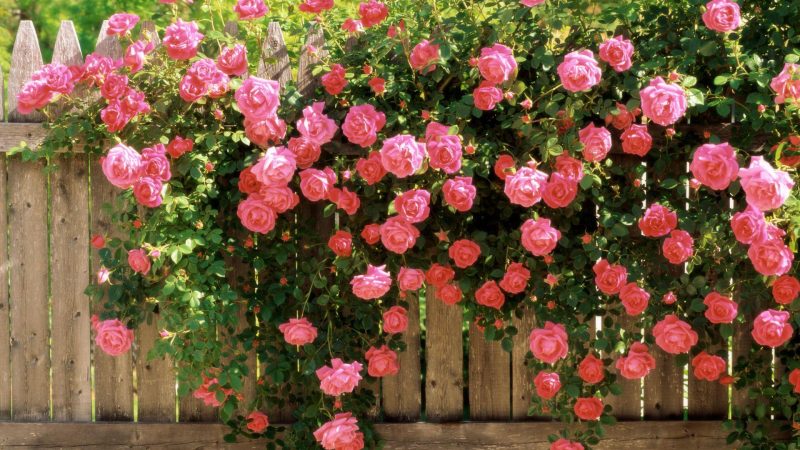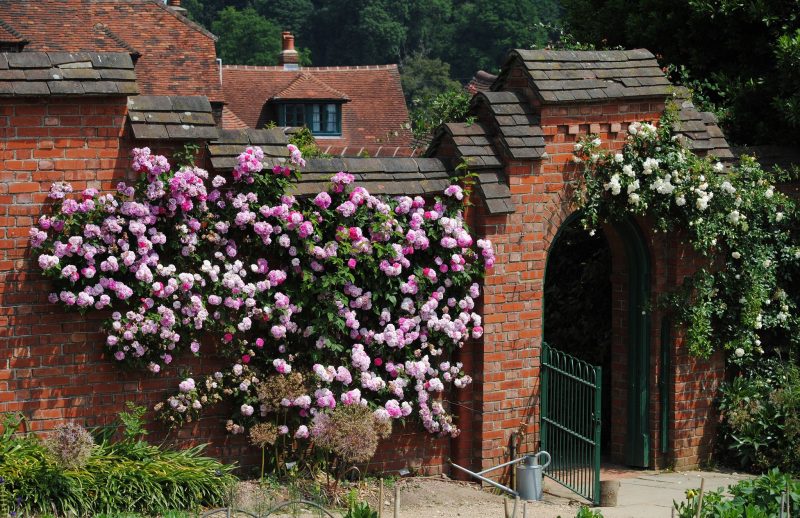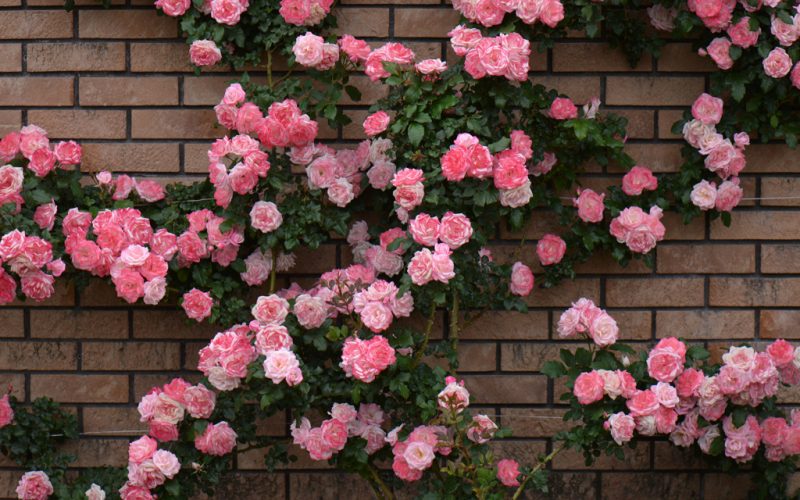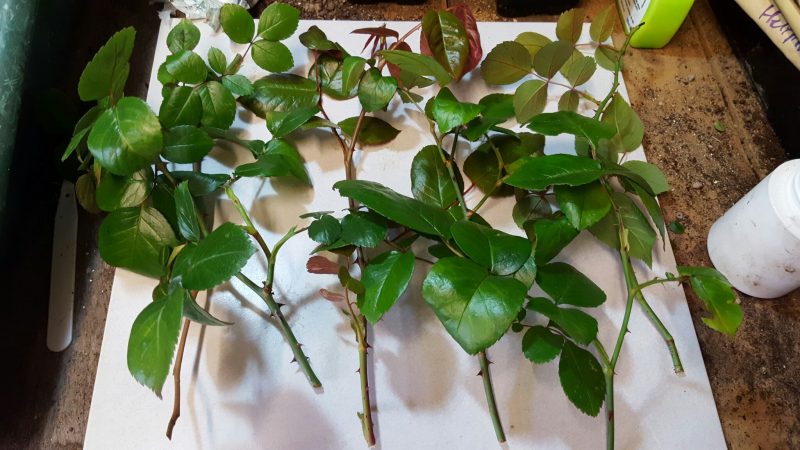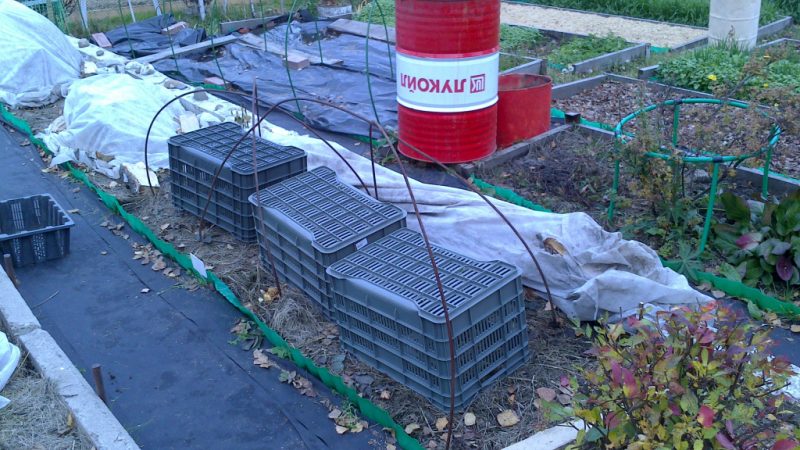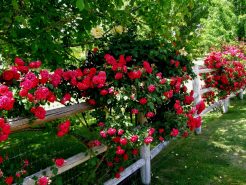Long, graceful shoots with bright flowers are an excellent material for vertical gardening of the facade, terrace, arbor and fence. In the south, curly roses do not need winter shelter, but in the middle lane should be protected from frost. In spring, the whips with new strengths "storm" the walls, climb up openwork lattices and decorative columns.
Material Content:
Description and features of species and varieties
Curly roses evolved from many wild and cultural "ancestors." There is no generally accepted classification, mainly groups of varieties are characterized by shoot growth, origin, bud size. Semi-climbing plants grow up to 3 m in height, the length of shoots of climbing roses - from 3 to 5 m, curly - from 5 to 15 m. The flowers can be simple, semi-double or double. Usually large buds are located singly, and small and medium ones are collected in racemose or paniculate inflorescences.
Types of small-flowered climbing roses - the ancestors of modern varieties:
- R. sempervirens (evergreen) has thin lashes 5 m long. Fragrant white flowers are quite large for rose hips - up to 4.5 cm in diameter. Sempervirens rose hybrids are in demand due to their high winter hardiness.
- R. setighera is another initial species of varieties of climbing roses that are resistant to cold. Wild plants are found in southern Canada.
- R. field - one of the ancestors of roses belonging to the group of varieties Aishira. The shoots of plants in nature reach 2 m. The flowers are simple, white, fragrant. The heat-loving field rose in Russia is not widespread.
- R. multiflora is a bush with long shoots (up to 3 m), small white or pink flowers.
Previously, in all flower classification classifications, a group of rambler varieties was mentioned - climbing or real climbing roses. They descended from R. multiflora and R.Visurana. Plants with flexible shoots 2-5 m long bloom once a season (remontant). Simple, semi-double and double flowers of climbing roses are collected in inflorescences, the smell is weak or absent.
Variety "Adzhimushkay" - a curly rose that blooms all summer. Shoots up to 2 m long, cup-shaped flowers, terry. The reverse side of bright red petals is lighter. The variety is suitable for vertical gardening.
As a result of breeding work, large-flowered climbing roses were obtained - Climbers (climbing):
- Alibaba. The color of large, double flowers is coral pink. One of the relatively young varieties.
- Elfe. Long lashes grow up to 2 - 3 m. Large, densely doubled flowers attract attention with an unusual color - a combination of ivory with a pale green base of the petals.
- Climbing Bonica. The buds are cup-shaped, the color of the petals is pale pink. The length of the shoots is up to 4 m. The plant is resistant to fungal infection.
- Coral Dawn. On lashes up to 2.5 - 3.6 m long, cup-shaped terry flowers bloom, single or 3 to 5 pieces in racemose inflorescences. Petals are first coral pink, then brighten.
- Maigold. Liana reaches a length of 4 - 6 m. Flowers of May May bloom in late spring, attracting attention from afar by apricot, golden and yellow hues. A popular variety due to winter hardiness and ease of propagation by cuttings.
- Harlekin. Large double flowers bloom on strong climbing shoots. The color of the petals is from pale pink to bright raspberry. Flowering lasts all summer. The bush tolerates frosts from −23 to −31 ° C.
Climbing roses climings differ from the previous two groups in that they have twin bushes. 2–8 m long lashes deftly climb onto supports. Delicious buds bloom on the branches once or twice during the summer. Flowers are suitable for cutting.
Winter-hardy varieties of climbing roses have spread in central Russia and Siberia. These are “New Down” (a hybrid of Vishurana), “Rosarium Jutersen” (Klaymbers), “Westerland” (floribunda), “Flammentants”.
Preparing and planting flowers
Climbing roses are planted, grafted on dogrose or root, in autumn or spring in moist soil. Separate bushes are located at a distance of 0.5 m from each other, 0.4 - 0.5 m from the support of the wall of the building, lattice, fence.
Roses prefer well-lit areas, open in the south and south-west direction, protected from strong winds.
Planting pits with a depth and diameter of about 50 cm are prepared in advance. A drainage layer of broken brick or expanded clay is poured to the bottom, humus or compost is added (up to ½ bucket per bush). Organics not only enrich the substrate, but also makes the soil more breathable. Liming of acidic soil is carried out so that the pH value is neutral.
If the substrate dries, then the day before the planting of a climbing rose, water is poured into the pit. The root ball of the seedling is placed, the soil is poured, knocked around the edges, tamped and watered. Trim the bush at a distance of 20 cm from the surface of the earth to stimulate growth.
The nuances of caring for curly roses
Need plentiful, but not frequent watering, 3 or 4 times a month. For top dressing, you can use special mixtures intended for roses, or complex peat-mineral fertilizers, including basic nutrients. It is useful to mulch the soil with sawdust, humus, fresh grass after watering and top dressing. Adult bushes fertilize 4 to 5 times per season.
The task of pruning in the second and subsequent years is to give the roses the desired shape, thin out the bush from the inside for better breathability and disease prevention.
In the fall, when frosty days begin, they take off and shelter the liana. In spring, shoots open, inspect on the ground. If necessary, remove frozen, rotted branches. Raise and tie the rose to the supports after the growth of substitution shoots to 25 cm.
In summer, wilted flowers and inflorescences are cut to stimulate the growth of new buds.After flowering, lateral shoots are shortened, leaving 3-5 buds. If the branches are very elongated, then you can cut them to an acceptable length. Anti-aging procedure - shortening half of the branches of a rose to 30 - 40 cm above the ground. After the appearance of new shoots, you can completely cut out the old ones.
Breeding methods
Available to all gardeners, a method of obtaining planting material is the rooting of cuttings.
- Cut from green shoots starting to wood, areas 25 cm long, at least 5 mm in diameter, with 3-4 well-developed buds.
- On each handle, flowers, thorns, leaves are removed, leaving two in the upper part.
- An oblique section is made and the lower part is soaked for a day in a solution of a growth stimulator (“Heteroauxin” or “Kornevin”).
For rooting, use pots or containers filled with a mixture of humus or peat with coarse sand. The cuttings are planted to a depth of 1 cm, moistened with water. Top with cropped plastic bottles. In this way, curly, tea-hybrid, park roses and floribunda are propagated.
Cuttings can be rooted in a garden bed. The soil mixture for planting is prepared in the same way as for pot culture.
- Furrows are made to a depth of 20 cm, filled with prepared substrate, wet sand.
- Cuttings are placed obliquely at a distance of 10 cm.
- Each is covered with a cropped plastic bottle.
- The sand is wetted so that it is constantly moist, but not wet.
After a month, up to 100% of cuttings are rooted.
Another method of vegetative propagation of large-flowered climbing roses is budding. Rosehip bushes are rosehips at the age of 1 - 2 years. The method is more complicated than grafting. They carry out budding in August with a sleeping eye in the root neck of the stock.
Plant diseases and pests
Curly roses are susceptible to fungal infections. Powdery mildew is most harmful. Affected plants are sprayed with Bordeaux fluid. The tool is prepared from a suspension of slaked lime and a solution of copper sulfate. Bushes are treated in early spring before buds open, a second time after the growth of young shoots.
Dangerous, voracious pests of all groups of roses - aphids and spider mites. Solutions for spraying from pests are prepared from infusion of tansy, tobacco, garlic, tomato leaves. If treatment with folk remedies does not help, then chemical and biological preparations are used. The acaricidal preparations Aktofit and Vertimek cope with spider mites.
To combat aphids, use the following means:
- "Actofit" (insect-acaricide);
- "Commander";
- "Actellik";
- "Actara."
Pests winter on fruit trees in the garden, breed in the summer on weeds. It is necessary to carefully clean diseased and dry branches, rotting fruits, weeds. For planting, it is better to use seedlings of climbing roses that are resistant to disease.
Technology of sheltering roses for the winter
In the middle zone, the thermophilic varieties of the Queen of the Garden require protection against frost. Start work with a steady decrease in temperature. First, the lashes of curly roses are removed from the support. On the ground, shoots are cleaned of leaves, damaged branches are cut out. Before the onset of frost, they carefully knit the whips with a rope, lay them on the spruce branches, and press them to the ground with arcs of metal rods. Young bushes spud with soil mixed with sand.
The rope can be replaced with old nylon tights, lapnik - with polystyrene from the packaging of household appliances.
Top roses are covered with cardboard or wooden shields. The entire structure is covered with a film to protect against rainfall. You can do it another way: remove the lashes of curly roses with trellises, lay on the ground or lapnik. Further, the sequence of shelter is the same as in the first embodiment.
There are other technologies that are adapted to the climatic conditions of specific regions, relief, varieties of roses. Often the branches bend badly, break when trying to lay them on the ground for shelter.In this case, experienced flower growers recommend cutting the shoots to the desired length, which will save the bush.
It is interesting:ground cover perennials - plants
Use in landscape design
Any blossoming creepers are an excellent decoration of the terrace, arbors, pergolas, arches in the garden. Curly roses with white and pink buds will create a romantic atmosphere in a corner of relaxation. If you use varieties of this group with white, yellow, pink flowers, the garden will visually expand.
Vines can grow trees and shrubs, that's how they behave in nature. Other climbing plants can be planted between climbing roses: honeysuckle, honeysuckle, clematis. Vines are combined with boxwood, as well as undersized herbaceous plants with bright large flowers - daffodils, tulips, primrose.


